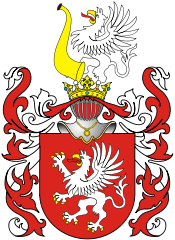| Families |
329 names altogether: Aksamitowski, Aksentowicz, Andronowski, Andrzejkiewicz, Ankowski, Axamitowski, Axentowicz, Batowt, Bawołowski, Bąkowski, Bąkowski-Jaksa, Beda, Behme, Belicki, Beliski, Bełhacki, Bełzki, Bielicki, Bieniaszewski, Bieniażewski, Bilański, Bitowt, Bitowtowicz, Bober, Bobowski, Bobriński, Bobrowicz, Bokowski, Borkowicz, Borzesławski, Borzysławski, Botowicz, Botowt, Bóbr, de Branice Branicki, Brański, Braun, Brzeżnicki, Brzeziński, Brzeźnicki, Bubowski, Burzyński, Butowd, Butowt, Buttowt, Bykowski, Bykowski Jaxa, Ceder, Cedro, Cedrowicz, Cedrowski, Chamiec, Chamski, Charzewski, Chicki, Chłądowski, Chłędowski, Chomski, Chrapkowicz, Chroniowski, Chronowski, Chycki, Chyćko, Ciepielewski, Ciepielowski, Cykowski, Czajański, Czajęcki, Czaykowski, Czepielewski, Czepielowski, Czykowski, Dębicki, Dobek, Doberski, Dobkiewicz, Dobko, Domaradzki, Dowiat, Dziwisz, Gąbski, Gedajmin, Getkin, Getka, Getko, Gębski, Gędka, Giedczycki, Giedczyński, Giedecki, Giedymin, Giedziński, Gienk, Gienko, Gierntowt, Gładysz, Gładyszewski, Gołąbek, Gosicki, Goszycki, Grefkowicz, Grodzicki, Gross, Gruźdź, Gryczka, Gryffin, Gryfita, Gryfin, Grynkiewicz, Grzywaldzki, Grzywladski, Gumieniecki, Gunther, Gwoździowski, Haszlakiewicz, Hausman, Hromyk, Hronowski, Hroznowski, Hrydzicz, Ilsinger, Iżyron, Jaksiński, Jakszewicz, Jarken, Jaworski, Jawszyc, Jaxa, Jencewicz, Jeńcewicz, Kawecki, Kawiecki, Kąsieński, Keller, Kępski, Khański, Kicki, Kiertut, Kijański, Kilski, Kleszczewski, Kleszczyński, Klewszczyński, Kober, Kobr, Kobro, Komornicki, Konarski, Korabka, Kosmynowski, Kosmyszewski, Kossowicz, Kośmierzowski, Kośminowski, Koświcz, Kowarski, Krobanowski, Kromołowski, Krukowski, Kruszowski, Krzeczewicz, Krzeczowicz, Krzeszowicki, Krzeszowski, Krzyszewski, Kwiatkiewicz, Kwiatkowicz, Kwiatkowski, Kwieciński, Lange, Latosiński, Latoszyński, Laudyn, Lechowicz, Leńkowski, Leśniewski, Leśniowski, Leśniowski de Zimnowoda, Lewczenko, Ligęza, Lobowski, Lowczowski, Lubczewski, Luzeński, Ładoszyński, Łobowski, Łobzowski, Łotwiszyński, Łowczewski, Łowczowski, Łowczycki, Łupiński, Makulski, Maleszewski, Maleszowski, Maliszenko, Maliszowski, de Małachowo Małachowski, Maniukowski, Marcinkowski, Marcinowski, Mąkolski, Micherowski, Michora, Michorowski, Michowski, Michowski, de Mielec Mielecki, Mikołajowski, Mikoszek, Mikoszko, Milecki, Mirzowski, Molenda, Molendziński, Mykoszek, Myrzowski, Nasiechowski, Nasięchowski, Nast, Nasto, Neledyński, Nieklewicz, Niklewicz, Noskowski, Nowoszewicz, Okołowski, Osowiecki, Ossowiecki, Ossowski, Ostrowski, Otffinowski, Otfinowski, Otwinowski, Paciorkowski, Paluchowski, Panterewicz, Panterowicz, Papieski, Papiewski, Papiński, Papuski, Piskorzewski, Pobiedziński, Podegrodzki, Podgrodzki, Podogrodzki, Połucki, Potucki, Prochański, Procheński, Pruchański, Prucheński, Raczkiewicz, Radliński, Rakowski, Rankowicz, Ratarski, Ronikier (seem wrongly attributed to the Clan for the similarity of arms only), Rosławiec, Rosłowicz, Rosłowiec, Rotarius, Rotariusz, Rotarski, Rotarski, Rozen, Rożen, Rożenkowski, Rożeński, Rożno, Ruszczycki, Sabina, Sczepanowski, Skrzyszowski, Słocki, Slominski, Stanisławski, Stroniowski, Strzeszkowski, Studzieński, Swoszowski, Syrochowski, Szczepanowski, Szczodry, Szczukowski, Szczynecki, Szlydyen, Szołomski, Sztukowski, Święszek, Taonowicz, Treska, Tresko, Trestka, Treszka, Trojacki, Trojecki, Trzeciecki, Trzeciewski, Turski, Ujejski, Ulkowski, Warchałowski, Wdowieszyński, Weszmunt, Wierzbicki, Wiktorowski, Wilkowski, Wodnicki, Wolski, Wosztort, Wosztowt, Wyszko, Zadrożny, Zajezierski, Zakomorny, Zakrzewski, Zamiechowski, Zamierowski, Zanietowski, Zaporski, Ziema-Grodzicki, Znamierowski, Znamirowski, Zołotar, Żarliński, Żeromski, Żeromski Jaxa, Żeromski-Jaxa, Żukowski, Żyzmiński |

